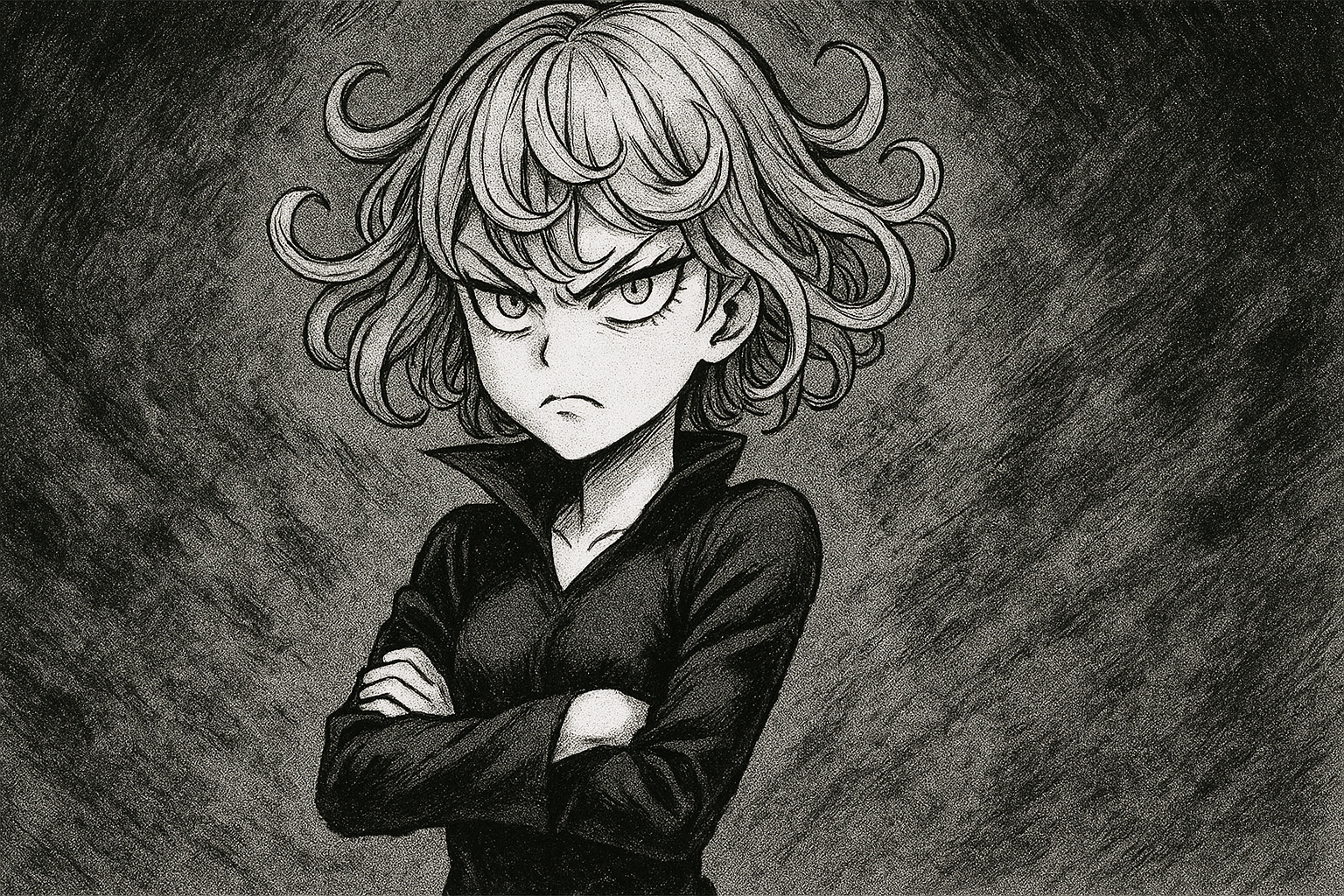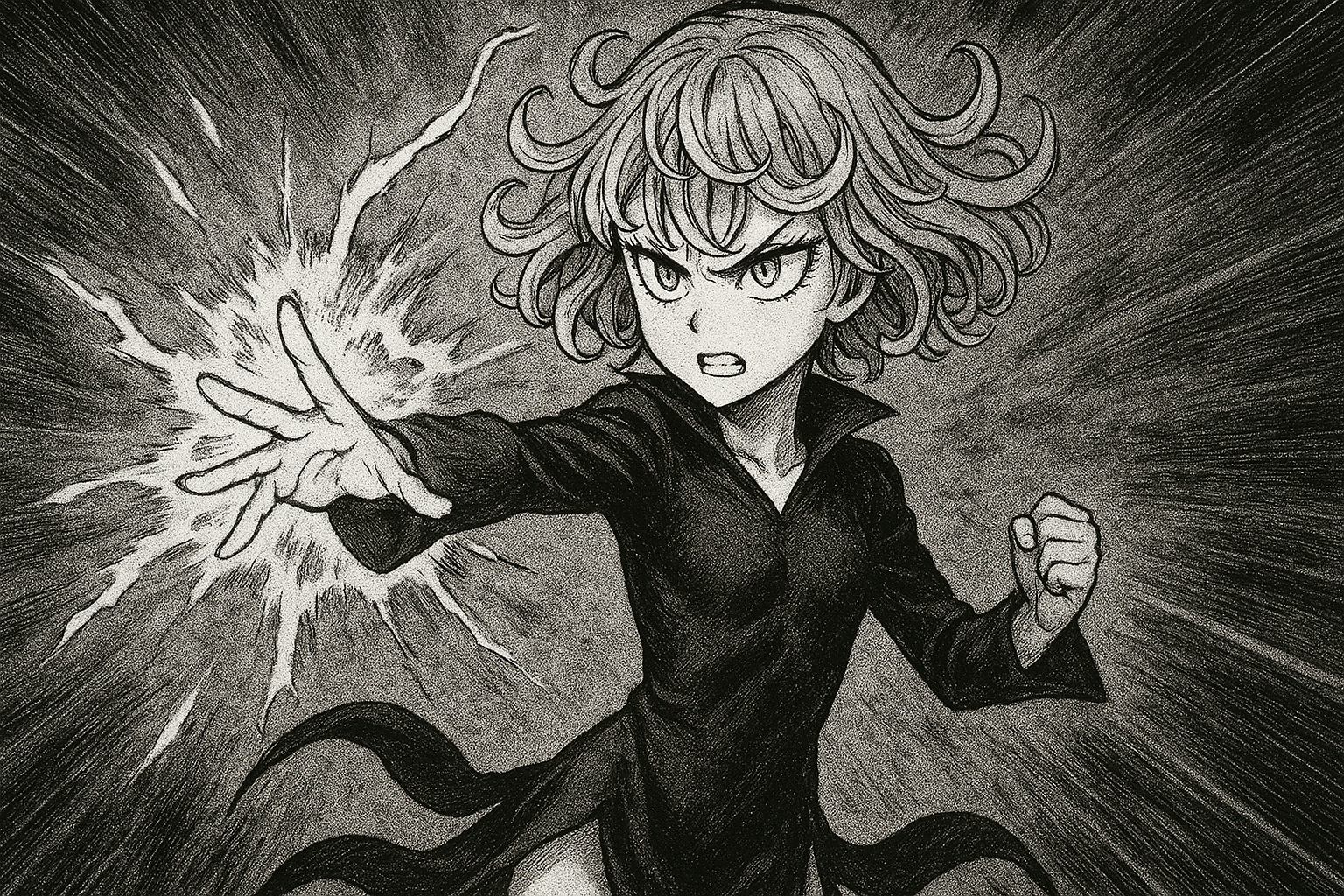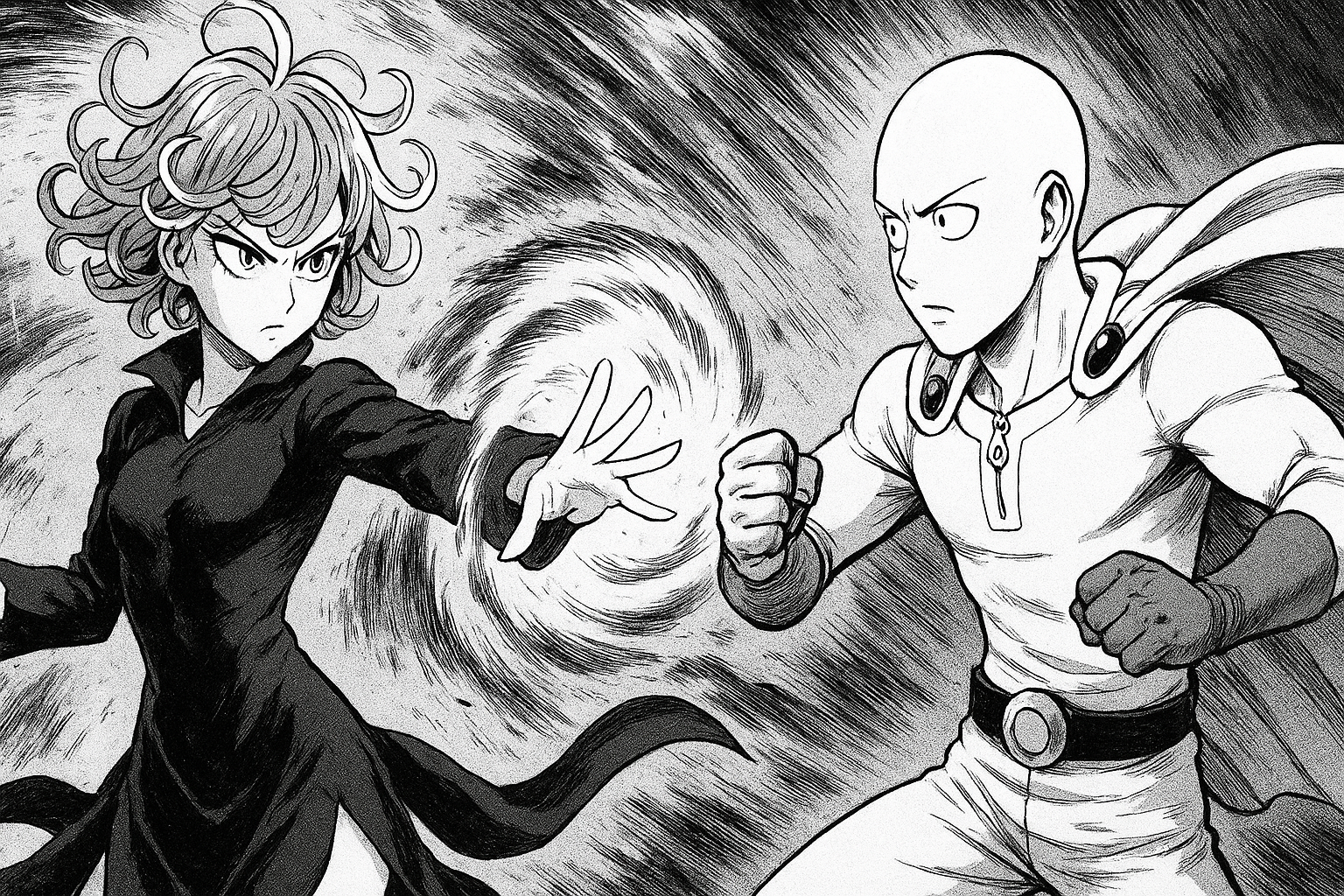One Punch Man Tatsumaki
One Punch Man Tatsumaki
In the chaotic and often comical world of One Punch Man, where heroes and monsters clash with earth-shattering force, few characters command as much immediate respect and fear as Tatsumaki. Known professionally as the S-Class Rank 2 hero, “Tornado of Terror,” she is a petite figure whose power is inversely proportional to her stature. With a mere flick of her wrist, Tatsumaki can rewrite the landscape, lift entire cities, and obliterate threats that would decimate entire hero squads. But who is the woman behind the devastating psychic power? This article delves deep into the whirlwind that is Tatsumaki, exploring her origins, her unparalleled abilities, her complex psychology, and her undeniable impact on the One Punch Man narrative.
The Esper in Green: One Punch Man Tatsumaki
Tatsumaki is instantly recognizable by her signature look: a simple, form-fitting black dress contrasted with voluminous green curls. Her perpetually bored and condescending expression perfectly encapsulates her personality. She is not a hero who seeks admiration or fame; she operates with a brutal efficiency born from the belief that she is the only one capable of handling the world’s gravest threats. This arrogance, however, is not without foundation, as her track record of victories is nearly unblemished.
A Traumatic Origin: The Roots of Power and Distrust
Tatsumaki’s immense power and deep-seated distrust of others stem from a horrific childhood. She was not born a hero but was instead a lab subject. A secret government organization, seeking to create the ultimate psychic weapon, kidnapped her and her younger sister, Fubuki. Confined and experimented on, Tatsumaki’s powers were a curse before they were a gift. This period of isolation and exploitation forged her core belief: to rely on no one but herself, as adults and institutions are inherently untrustworthy.
The Unshackling: A Savior Named Sitch
Her confinement was not permanent. The story of her rescue is a legendary tale within the Hero Association. A high-ranking official named Sitch, recognizing the inhumanity of her situation, defied his superiors and orchestrated her release. He is one of the very few people Tatsumaki holds in high regard. This act of genuine kindness, free from ulterior motive, planted the seed that she could use her power for something other than destruction, setting her on the path to becoming a hero.
Deconstructing Esper Abilities: More Than Just Telekinesis
While often simplified as “telekinesis,” Tatsumaki’s abilities are a masterclass in psychic prowess. Her power is a multi-layered defensive and offensive system:
-
Telekinetic Manipulation: The core of her ability, allowing her to move, crush, and bend matter at a planetary scale.
-
Psychic Barrier: An automatic, near-impenetrable shield that protects her from physical, energy, and even psychic attacks.
-
Flight: Effortless levitation and high-speed aerial movement.
-
Energy Manipulation: The ability to create and redirect energy blasts.
-
Matter Reconstruction: She has shown the ability to reassemble complex structures, like an entire city, after a battle.
Tatsumaki Showcase
Season 3 will be the definitive season for Tatsumaki. Moving beyond the brief skirmishes and displays of power from previous seasons, this arc places her at the forefront of the conflict, pushing her abilities to their absolute limits and beyond.
The Central Conflict: The Monster Association Raid
The Hero Association’s all-out assault on the Monster Association headquarters serves as the primary backdrop. When several S-Class heroes are defeated or incapacitated, Tatsumaki takes it upon herself to end the threat single-handedly, leading to her most iconic and brutal battles.
Detailed Breakdown of Tatsumaki’s Abilities in Season 3
Season 3 will visually demonstrate why Tatsumaki is ranked S-Class #2 and is considered the Hero Association’s ultimate weapon.
Psionic Might: Scale and Precision
We’ve seen her lift buildings and stop shells. In Season 3, the scale of her telekinesis is redefined.
-
Uprooting the Entire Base: Her most famous feat from this arc is her effortless uprooting of the entire, massive Monster Association headquarters from its foundations deep underground. She doesn’t just lift it; she twists the entire colossal structure like a corkscrew out of the ground, demonstrating power on a geographical scale.
-
Barrier Penetration: She precisely targets and extracts all the captured civilians from deep within the monster base while simultaneously engaging multiple Dragon-level threats, showcasing an incredible level of multi-tasking and fine control.
Defensive Prowess: The Unbreakable Psionic Barrier
Tatsumaki’s automatic passive barrier is tested like never before.
-
Ultimate Durability: It effortlessly deflects attacks that would vaporize other S-Class heroes, including energy blasts, physical strikes, and psychic assaults.
-
The “Weak Point” Exploited: A major plot point will be her old head injury, sustained from a childhood experiment. The cunning monster Psykos discovers this and uses a concentrated psychic blast aimed directly at this injury to momentarily disrupt her barrier, leaving Tatsumaki vulnerable for the first time. This leads to a severe head wound that significantly weakens her, showing that her power is not infallible.
Offensive Applications: Brutal and Creative
Her combat style becomes far more vicious and direct.
-
Weaponizing the Environment: She doesn’t just throw rocks. She compresses the surrounding earth and rock into tiny, hyper-dense pellets and fires them at supersonic speeds, turning the landscape itself into a deadly projectile weapon.
-
Internal Destruction: She demonstrates the ability to bypass external durability by twisting and crushing enemies from the inside out, a terrifying application of her power.
-
The “Spear of Heaven”: In a climactic moment, she creates a massive, spiraling lance of psychic energy and rams it directly through the monster Psykos-Orochi fusion, a being of planetary-level threat.
Key Battles to Look Forward To:
-
Tatsumaki vs. Psykos & Orochi (Fused): This is the main event. Tatsumaki, while already injured, takes on the fused form of the psychic mastermind Psykos and the monstrous dragon Orochi. Despite her injury, she dominates the majority of the fight, showcasing why she is in a league of her own.
-
Tatsumaki vs. The Cadres: She effortlessly handles multiple Dragon-level threats simultaneously, including Gums, Fuhrer Ugly, and Evil Natural Water, swatting them aside like insects before her confrontation with Psykos.
-
Tatsumaki vs. Garou: This is a crucial and highly anticipated clash. An awakened Garou, having surpassed his previous limits, challenges her. Their fight is a brutal exchange of overwhelming power versus adaptive, monstrous technique. It pushes a heavily weakened Tatsumaki to her absolute brink and serves as a benchmark for Garou’s terrifying growth.
Character Depth and Vulnerabilities
Season 3 will also explore the person behind the power.
-
Her Limits: We see her pushed to exhaustion, bloodied, and battered, proving that even the “Terrible Tornado” has a breaking point.
-
Protective Nature: Her actions, while arrogant, are driven by a desire to protect the other (weaker, in her view) heroes and ensure the mission’s success, adding a layer of complexity to her abrasive personality.
-
Relationship with Fubuki: The dynamic with her sister, Fubuki (The Blizzard of Hell), will be further explored, highlighting their strained past and Tatsumaki’s overbearing but protective nature.
Why Season 3 is Tatsumaki’s Season
In short, One Punch Man Season 3 will transform Tatsumaki from a powerful, mysterious figure into a fully realized and showcased force of nature. You will witness:
-
Feats of Power that dwarf anything she has done before.
-
Creative and brutal applications of her telekinesis in combat.
-
Her vulnerabilities and limits being tested and exploited.
-
Crucial character development that adds depth to her powerful exterior.
For any fan of Tatsumaki or awe-inspiring animated battle sequences, her display of abilities in the upcoming Season 3 is poised to be one of the most memorable highlights of the entire One Punch Man series.
Feats of Unimaginable Power: Lifting Cities and Stopping Meteors
Tatsumaki’s power isn’t theoretical; it’s demonstrated in staggering feats that define the upper limits of the One Punch Man universe. Some of her most iconic moments include
-
Lifting Z-City: To expose the Monster Association headquarters, she physically ripped the entire subterranean base from the ground, lifting a massive portion of a city into the air.
-
Twisting the Entire Monster Association Base: She contorted the labyrinthine base like a pretzel, effortlessly defeating countless monsters trapped inside.
-
Stopping the Giant Meteor: While Saitama ultimately pulverized it, Tatsumaki was able to significantly slow and fracture the massive meteor threatening Z-City, a feat no other hero present could even attempt.
The S-Class Standoff: Tatsumaki’s Rivalry with Blast
As the S-Class Rank 2 hero, Tatsumaki is officially second only to the mysterious and absent Rank 1, Blast. She holds a simmering resentment towards this position, not out of petty jealousy, but because she genuinely believes she is the strongest. She sees Blast’s absence as a dereliction of duty and is determined to prove that she is the true pinnacle of heroism, capable of handling any crisis without needing a legendary figure to fall back on.
A Troubled Psyche: The Loneliness of Being the Strongest
Beneath the abrasive and arrogant exterior lies a profoundly lonely individual. Tatsumaki’s childhood trauma and her sheer, unmatched power have created an impenetrable wall around her. She pushes people away preemptively, believing that dependence leads to weakness and betrayal. This isolation is a key part of her character, making her moments of vulnerability—often only seen with her sister—all the more significant.
Sisterly Conflict: The Complex Relationship with Fubuki
Tatsumaki’s relationship with her younger sister, Fubuki (the “Blizzard of Hell”), is one of the most nuanced in the series. Tatsumaki’s overbearing protectiveness stems from her traumatic past; she wants Fubuki to be strong enough to never be victimized again. However, her methods are oppressive, as she constantly belittles Fubuki’s B-Class Group and tries to force her into a solitary life of power-building. This conflict drives much of Fubuki’s own character development.
Tatsumaki vs. Saitama
The dynamic between Tatsumaki and Saitama is central to both their character arcs. Saitama represents everything Tatsumaki cannot comprehend: ultimate power without ego, effort, or a tragic past. His nonchalant attitude infuriates her because it devalues the very struggle and power that define her existence. Their battles are less about physical combat and more about a clash of ideologies, forcing Tatsumaki to confront the possibility that her worldview might be flawed.
The Climax of Terror – Tatsumaki vs. Saitama
This fight is not just a random skirmish; it’s the dramatic core of the season’s final act, stemming from a critical misunderstanding and a clash of ideologies.
Part 1: The Setup & Context (Why They Fight)
-
The Monster Association Raid: The Hero Association’s S-Class heroes have launched a full-scale assault on the Monster Association’s base. The battle is brutal, with many heroes being defeated or incapacitated.
-
Tatsumaki’s Burden: As the #2 S-Class hero and the association’s ultimate weapon, Tatsumaki takes it upon herself to handle the most significant threats. She believes the other heroes are nothing but dead weight and that she must fight alone to ensure victory.
-
The Critical Misunderstanding:
-
Psykos’s Deception: The villain Psykos (fused with Orochi) mentally communicates with Tatsumaki, pretending to be the captured hero Fubuki (Tatsumaki’s sister).
-
The False Plea: “Fubuki” claims that the lower-ranked heroes, specifically mentioning Saitama and Genos, have betrayed the heroes and are planning to kill Tatsumaki once she’s weakened from fighting.
-
-
Tatsumaki’s Wrath: Already stressed, injured, and fiercely protective of her sister, Tatsumaki fully believes this lie. She decides to preemptively neutralize the perceived threat. She effortlessly defeats Genos (dismantling him in seconds) and then turns her attention to the source of the “betrayal”—Saitama.
Part 2: The Fight Breakdown (The How)
The battle can be divided into distinct phases, showcasing the absolute gap between the world’s most powerful esper and a man who has removed his limiter.
Phase 1: The Assault on the Base
-
Tatsumaki’s Opening Move: Believing Saitama to be a significant (but manageable) threat, Tatsumaki doesn’t hold back. She uses her telekinesis to twist and compress the entire Monster Association base into a massive, condensed ball of rubble, intending to crush Saitama inside it.
-
Saitama’s Nonchalance: Saitama is simply annoyed. He’s not there to fight her; he’s just looking for a way out. He casually punches through the compressed rock and debris, emerging completely unscathed and unimpressed. This is the first hint to Tatsumaki that something is wrong.
Phase 2: The Descent & The True Power of the Tornado
-
The Underground Battle: The fight moves deep underground. Now taking Saitama more seriously, Tatsumaki unleashes her full arsenal:
-
Telekinetic Barrage: She hurls colossal spears of bedrock at him.
-
Environmental Control: She twists the very geography of the underground caverns, trying to crush or bury him.
-
Direct Assault: She attempts to directly twist his limbs and body with her psychic power.
-
-
Saitama’s Immunity: The central joke and awe of the fight is that Tatsumaki’s powers have zero effect on Saitama’s body. He walks through her attacks, yawns, and complains about the inconvenience. Her telekinesis simply slides off him as if he’s a fundamental law of the universe that cannot be altered.
Phase 3: The Serious Table Flip
-
Tatsumaki’s Desperation: Realizing her conventional attacks are useless, Tatsumaki performs her most incredible feat yet. She uses her power to rip a continent-sized section of the planet’s crust out of the ground, flipping the entire battlefield upside down and exposing them to the surface.
-
Saitama’s “Response”: Even this astronomical display of power doesn’t faze Saitama. He’s more concerned with the fact that the fight has ruined his clothes. He simply falls back to the ground, unharmed.
Phase 4: The Conclusion – A Lesson, Not a Defeat
-
Tatsumaki’s Exhaustion: Pushed beyond her limits, both physically and mentally, Tatsumaki collapses from psychic overuse and her pre-existing injuries.
-
Saitama’s “Serious Move”: As she falls, Saitama doesn’t punch her. Instead, he performs a “Serious Headbutt,” a non-lethal but impactful move that finally makes her understand the sheer, insurmountable gap in their power. It’s not enough to seriously hurt her, but it’s more than enough to shatter her pride and prove his point.
-
The Aftermath: Saitama catches her and gently places her next to her sister, Fubuki. He doesn’t gloat or act like a victor. He simply states that she should stop trying to do everything alone and learn to rely on others.
Part 3: Significance & Character Development
-
For Tatsumaki: This fight is a watershed moment. Her entire worldview—that she is the strongest and must protect her weak sister alone—is completely dismantled. It’s the beginning of her long-overdue character development, forcing her to acknowledge others and slowly learn to lower her emotional barriers.
-
For Saitama: It reinforces his central problem: utter boredom. However, it also showcases his innate heroism and wisdom. He doesn’t fight to humiliate her, but to teach her a lesson about teamwork and trust.
-
For the Audience: It’s the ultimate display of Saitama’s “unbreakable” nature. If the most powerful psychic on the planet cannot affect him, then nothing can. It solidifies the series’ core theme.
How This Would Look in Season 3 (Production & Pacing)
-
Episodes Covered: This epic clash would likely be the focus of Episodes 10 and 11 of a 12-episode season, serving as the grand climax before the final episode deals with the aftermath and the next major threat.
-
Animation: This fight would be the animation spectacle of the season. Studio would have to go all-out:
-
Tatsumaki’s Powers: A kaleidoscope of vibrant green psychic energy, destructive shockwaves, and earth-shattering environmental destruction.
-
Saitama’s Simplicity: The contrast would be key. The animation around Saitama would be calm, with minimal effects, emphasizing how he negates her reality-bending power with simple movements.
-
The “Serious Headbutt”: This single move would need to be animated with immense weight and impact, a visual representation of Saitama’s power being “serious” for a split second.
-
-
Voice Acting: The VAs would need to masterfully portray Tatsumaki’s escalating rage and desperation, contrasted with Saitama’s unwavering boredom and mild annoyance.
The Monster Association Arc: A Testament to Her Tenacity
The Monster Association Arc is Tatsumaki’s magnum opus. She single-handedly carries the heroes’ offensive, taking on multiple Dragon-level threats simultaneously, including Psykos and the immensely powerful Evil Natural Water. Even after being severely wounded by a treacherous sneak attack, she continues to fight, showcasing not just her power but also her indomitable will and heroism when the fate of the world is at stake.
Weakness and Limitations: Is the Tornado Truly Invincible?
While phenomenally powerful, Tatsumaki is not without her limits. Her primary weakness is psychological. Her psychic barrier can be compromised if she is caught off-guard or if her concentration is broken, as seen with Psykos’ and Fuhrer Ugly’s coordinated attack. Furthermore, her arrogance can lead her to underestimate opponents, making her vulnerable to unconventional tactics. Prolonged battles against multiple top-tier Dragon-level threats can also drain her stamina.
Character Evolution: From Solitary Tyrant to Reluctant Ally
One of the most compelling aspects of Tatsumaki’s character is her gradual development. Post-Monster Association arc, her interactions with Saitama and the undeniable evidence of his strength force her to reevaluate her “lone wolf” philosophy. While still fiercely independent and abrasive, she has shown a slight capacity to acknowledge others, even begrudgingly accepting help and recognizing the strength of certain allies like Genos.
Tatsumaki in the Manga vs. Webcomic: A Tale of Two Tornados
For dedicated fans, it’s worth noting that Tatsumaki’s character portrayal has some differences between the original webcomic by ONE and the redrawn manga illustrated by Yusuke Murata. The manga expands significantly on her battles, showcasing her power with breathtaking artwork and adding more detail to her feats during the Monster Association arc. Her character arc, however, remains consistent, with the manga providing a more visually spectacular and extended narrative.
The Fan Phenomenon: Why We Love the Tornado of Terror
Despite her toxic personality traits, Tatsumaki is overwhelmingly a fan-favorite character. This is because she is a perfectly crafted “gap moe” character—the stark contrast between her childish appearance and god-like power is inherently entertaining. Furthermore, her tragic backstory fosters empathy, and her unwavering confidence and sheer power in a fight are incredibly satisfying to watch. She is complex, flawed, and utterly captivating.
The Future of the Tornado: What Lies Ahead?
As the One Punch Man story continues, Tatsumaki’s role remains crucial. With the looming threat of God and the increasingly powerful monsters emerging, her power will be needed more than ever. The central question for her character is whether she will continue to soften, learning to trust and cooperate with her fellow heroes, or if a future crisis will cause her to retreat back into her solitary shell. Her ongoing rivalry and strange relationship with Saitama will undoubtedly be a key factor in her future development.
Conclusion
Tatsumaki, the Tornado of Terror, is far more than just a powerful psychic in a world of superhumans. She is a deeply layered character whose strength is both her greatest asset and her most profound curse. From a traumatized test subject to the S-Class Rank 2 hero, her journey is a compelling exploration of power, trauma, and the slow, difficult path toward human connection. She embodies the central theme of One Punch Man—that power alone does not define a hero—while simultaneously being one of the most spectacularly powerful beings in the entire series. Whether she’s twisting a city into a spiral or having a petty argument with her sister, Tatsumaki remains an unforgettable and integral force in the world of One Punch Man.



